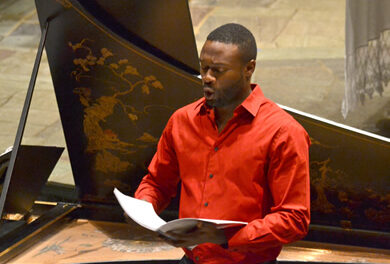The 2013 season of the Eastern Music Festival (EMF) ended with a glorious program featuring a work composed for Music Director Gerard Schwarz, probably the greatest concerto for any instrument, and a programmatic favorite containing some of the most popular melodies ever written. As has become somewhat of a tradition, the evening began with a well-articulated testimonial by one of the young music students about her experiences at this prestigious festival. That serves as a reminder that although for most of us the face of EMF is these spectacular concerts by professionals, it is the education and mentorship of the students that is the driving force, albeit mostly behind the public’s view.
It is a sign of the difficulty encountered by young composers to get played and accepted that even those who have received such recognition as the Rome Prize, as well as a Pulitzer, still toil in relative obscurity. Aaron Jay Kernis (b. 1960) is such a composer. He was one of 18 American composers commissioned by the Seattle Symphony to compose a new work for the 2010-11 Season in honor of Gerard Schwarz. Kernis’ contribution was “On Wings of Light,” inspired by the text “I take on wings of light and soar through all spaces of the heavens. I never come far enough and the desire always grows in me to go farther…” by philosopher/scientist Johann Heinrich Lambert. Prominently featuring the trumpet section (Schwarz served as principal trumpet of the New York Philharmonic from 1972-77), this is a rousing whirligig of an opener. Some of the orchestration is reminiscent of the sparkling quality of Respighi and is quite a virtuosic showpiece. On first hearing, it served mostly as a mood elevator without any discernible features to take home, but that is not necessarily a negative.
Although completed in Prague in the summer of 1895, Antonín Dvořák’s Concerto for Cello in B minor is among many of his great masterpieces conceived and composed while in the United States. The “Americanness” of this work goes one step further as it was cellist Victor Herbert — later to develop as a great composer in his own right — who served as Dvořák’s inspiration. Without a doubt this is the cello concerto, and arguably Dvořák’s greatest composition as well as the most popular concerto of any kind. The soloist for this program was the legendary American cellist Lynn Harrell, an internationally renowned performer, teacher, recipient of numerous prestigious prizes and collaborator with other great musicians. Perched on the traditional solo cello podium to the left of the conductor, Harrell — although not yet playing — was obviously infused with the majesty of the music during the long orchestral introduction. An enticing, deceptive cadence played by the French horns hung deliciously in the air as Harrell played the main theme followed by the famous (at least to cellists!) series of successive down-bow four note chords.
What follows is a mixture of beautiful slow melodic long lines and treacherous feats of technical brilliance that equal that of any of the pieces written for its smaller cousin that is oddly held between neck and shoulder. While it is expected that someone of Harrell’s stature can securely execute these difficulties, it was his consummate musicianship and beauty of sound that transcended the “oh wow” factor to that of expressive realization of the composer’s vision. The second movement, while somewhat slower, certainly does not lessen the magnificence of the work nor the soloist’s challenges. The finale brings back many of the great themes of the first movement and, very uncharacteristically, ends with the cello quietly tapering off while the orchestra rambunctiously races to the finish. It was apparent that Harrell was in control and Schwarz expertly transmitted the cellist’s vision to the orchestra. Despite a sustained, enthusiastic ovation, the audience was unable to coax Harrell back for an encore.
We’ve all heard the saying “If I had a dollar for every time (fill in the blank) I’d have (fill in an amount).” A variant of that could be “If I had a dollar for every time I heard the same theme in Nikola1 Rimsky-Korsakov’s Scheherazade I’d have at least enough to pay for my ticket.” That has been an underlying — and I believe misplaced — criticism of the great Russian’s symphonic suite that has become his most popular work. Based on episodes from The Arabian Nights, this is a wildly colorful four-movement work with descriptive titles. The opening movement, “The Sea and Sinbad’s Ship” is a magical musical montage of the ocean and presages Debussy’s La Mer by at least 15 years.
Wait, but there’s more. This could also easily be subtitled “Violin Concerto” as the concertmaster of the orchestra has a substantial solo part and is usually, along with the harp, the one who introduces the several remarkable themes. Jeffrey Multer played these solos with effortless grace and precision, especially the final statement in treacherous double stops. Rimsky-Korsakov is so audacious in his confidence as an orchestrator that he eschews even any pretense of developing these ravishing melodies. For the most part they are simply repeated in different instrumentation almost daring us to tire of these melodic gems.
Another EMF year has ended. I don’t feel the slightest bit overreach by saying again that their Festival Orchestra is among the finest I have ever heard — live or on recordings. With these players also serving as teachers to the EMF students, the future performance levels will continue to rise. Let’s hope there will still be sufficient orchestras and playing opportunities to sustain these artists.











